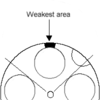Hi, Unspellable,
I am like you in remembering things but not the source. FWIW, I think Colt's "silver steel" was used in their springs, not in the whole gun, and was advertised that way.
The usual reason for going to five chambers is not a matter of gaining chamber web thickness, but of moving the cylinder stop notch away from the thin part of the chamber wall. This was not much concern in the old Colt DA revolvers, since the cylinder stop was well off to the side, but on guns like the Colt SAA type and the S&W type, where the stop is centered, the notch can weaken the cylinder wall.
I also remember those tests, and they were indeed done to show that the cylinder stop notch was not a weak area. That is true to a point, mainly because on S&W guns it is fairly small, even in large calibers. (Remember, when dealing with pounds per square inch, the square inches do matter.)
But on the Colt SAA type, the cylinder stop notch is larger and the cylinder wall is (I would think significantly) weaker at that point for that reason.
We agree that failure usually results in the webs at the sides being ruptured, but not on the sequence. I will stick by what I said. I have seen revolver failures where the only damage was a chamber split at the outer side; there was no damage to the web or to adjacent chambers.
I will note that in one case I saw (a .44 Magnum Ruger fired with a triplex(!!!) load - yes, three kinds of powder) the tops of three chambers blew off, the two adjacent webs split, and the top strap broke. BUT, the empty case and the unfired round in the adjacent chambers were intact, and showed no signs of being damaged by the pressure. The chamber walls had simply departed, where if the initial pressure had cracked the web first, the cartridges should have been at least dented, if not split or (in the case of the unfired one) discharged.
Jim





